Sexual Misconduct Prevention Progress Report 2022
Prepared by the Office of Equity and Access, April 2022
Table of Contents
Section 1: 50 Years of Title IX (1972-2022)
Section 2: OEA Title IX Initiatives A Look Back...and What's New in 2022
Section 3: A Look Inside the OEA Intake and Investigation Process
Section 4: How Does the University Keep Track of Title IX Incidents?
Section 5: Education and Outreach - How We Raise Awareness
Section 1: 50 Years of Title IX (1972-2022)
Jump to: Section 2 | Section 3 | Section 4 | Section 5
Title IX is a federal civil rights law that reads: “No person in the United States shall, on the basis of sex, be excluded from participation in, be denied the benefits of, or be subjected to discrimination under any education program or activity receiving Federal financial assistance.” The primary purpose of Title IX is to prohibit discrimination on the basis of sex and gender, including all forms of sexual harassment, sexual misconduct, and sexual violence in any education program or activity that receives federal funding. Stony Brook University understands this responsibility and is committed to a learning, working, and living environment that is free from discrimination on the basis of sex or gender and all other protected classes under federal and state laws. The Office of Equity and Access (OEA) is charged with upholding this commitment.
In 1972, President Richard Nixon signed Title IX into law as part of the education amendments to the Civil Rights Act of 1964. It was enacted to expand educational, career, and collegiate athletic opportunities for women. Patsy Mink, the U.S. Congresswoman from Hawaii, was the major author and sponsor of Title IX. Oregon Representative Edith Greene assisted with an early draft of the proposed law. Indiana Senator Birch Bayh co-authored the final draft of the bill that he introduced to the Senate while Mink introduced the legislation to the House. Mink was also the first Asian-American in the House of Representatives and the first Asian-American to run for president. In 2002, following her death, Title IX was renamed the Patsy T. Mink Equal Opportunity in Education Act.
The law affects all areas of education including career and technical education, STEM, recruitment, admissions, housing, pregnant, parenting and/or married students, financial assistance, student health services, insurance benefits, and athletics. Because of Title IX, women now make up more than 56% of America’s college students and women now hold 48% of tenure-track faculty positions. Since 1972, the number of female athletes has increased more than 10 times and female athletes make up 42% of all high school athletes. By comparison, in 1972 only 700 girls played soccer on high school teams; in 2018, there were 390,000.
How far we have come: how far we have to go
Despite the positive impact Title IX has had, there is more work to be done to secure equal educational experiences and opportunities for women. Nationwide, women continue to face significant obstacles, including in the field of education. Harassment continues to be a significant problem for female students, creating barriers to an equal education and future careers.
It is not only sexual harassment that impedes women in higher education. A 2017 Glassdoor study found that men dominate 9 of the 10 college majors that lead to the highest-paying jobs, all of which are in STEM fields, and 7 out of the 10 are in computer science and engineering. Women, by contrast, dominate 6 of the 10 lowest-paying majors and are at or near parity with men in two others.
Section 2: OEA Title IX Initiatives A Look Back…and What’s New in 2022
Jump to: Section 1 | Section 3 | Section 4 | Section 5
Title IX has evolved over the last 50 years with society’s understanding of discrimination “on the basis of sex” and how it impacts students and educators. The focus has expanded from its initial objective of increasing educational opportunity for females through admission to providing equal access to programs at educational institutions to ensuring that students of all sexes, genders, sexual orientation, gender identity, and gender expression have an equal opportunity to fully participate in all aspects of the educational program free from sex and gender-based discrimination, including sexual harassment and sexual violence.
|
Over that time, but during the last 10 years in particular, guidance and regulations from the federal Department of Education’s Office of Civil Rights (OCR), legislation from the State of New York, and SUNY requirements have impacted Stony Brook’s responsibilities under Title IX. Accordingly, Stony Brook University’s policies, programs, and responses have evolved as well. OEA has taken steps to ensure that we adhere to the changes while still striving to meet the needs of our entire campus community. OEA has led, partnered with other offices, or supported the establishment of many key changes and significant initiatives. Some of those programmatic additions include:
|
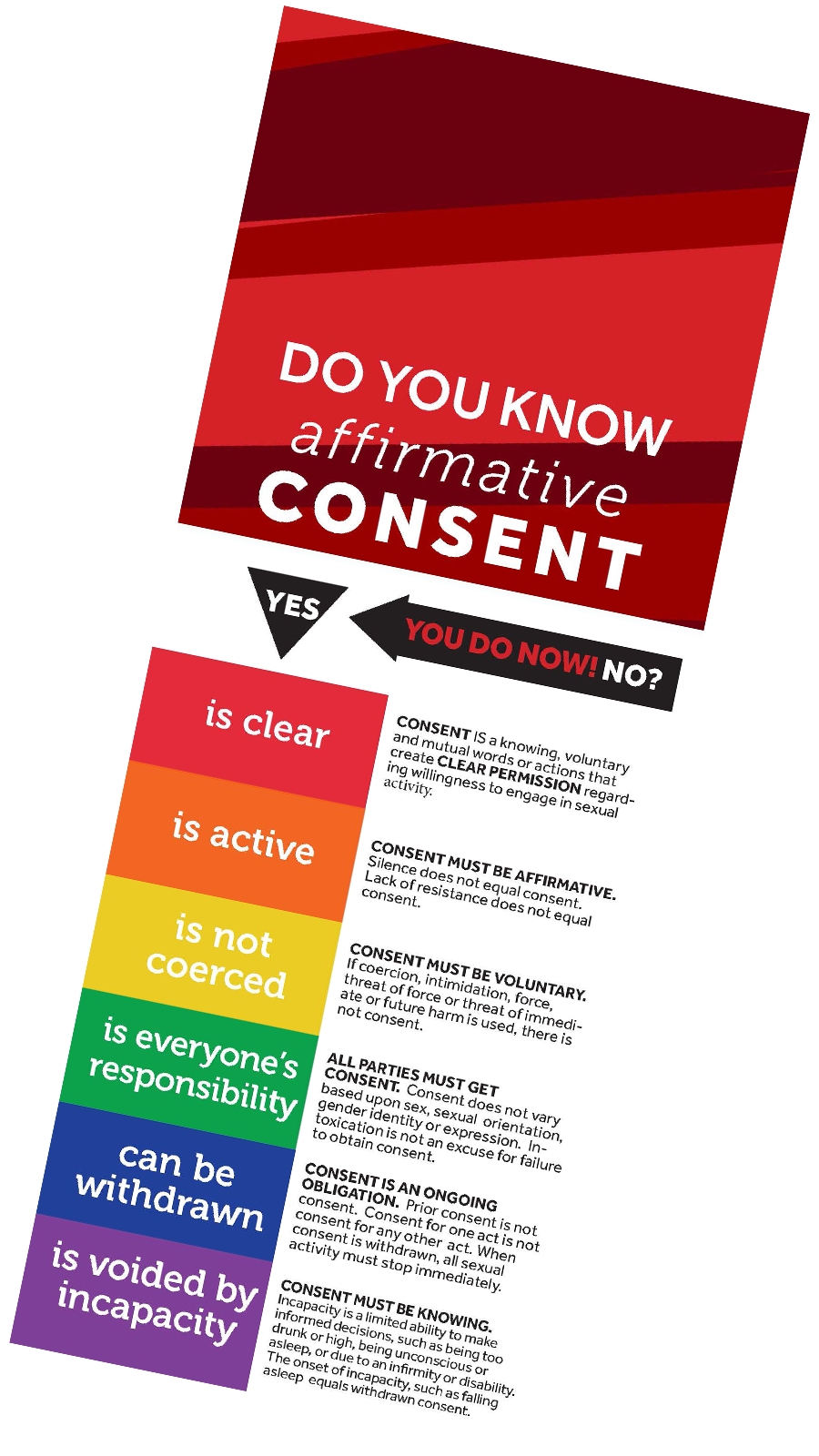 |
In March 2022, OEA established a Title IX (TIX) task force to review Stony Brook University's policies, procedures, and prevention efforts for sexual misconduct. The TIX Task Force is composed of faculty, staff and students across many areas of campus. In its initial meeting, the task force has identified five focus areas and established subgroups that will meet, brainstorm, and make recommendations to the task force as a whole, and ultimately to campus leadership. These groups will focus on investigations, student concerns, faculty concerns, staff concerns, and education and outreach. We expect these groups to provide various perspectives on what is working and where improvements can be made to promote reporting, raise awareness, and reduce and prevent incidents of sexual misconduct on campus.
If you have any recommendations for the task force to consider, please send them to titleix@stonybrook.edu.
Section 3: A Look Inside the OEA Intake and Investigation Process
Jump to: Section 1 | Section 2 | Section 4 | Section 5
What is the intake and investigative process from the time a report (or multiple reports of the same incident) is received?
Based on the information in the report, an initial assessment is made to determine (1) whether there is a possible SBU policy violation alleged; and (2) whether the allegation contains sufficient information for review under the Title IX process.
What is the process for submitting/receiving reports?
Reports may be submitted to OEA and Title IX staff in multiple ways - in person, via telephone, email, and/or the ReportIt website. Multiple reports regarding the same parties and/or incidents may be submitted in more than one way and OEA welcomes as much information as is available.
What happens when a complainant/reporter doesn’t respond?
When a reporting individual or complainant does not respond to our initial outreach, OEA makes several additional attempts to connect with the complainant and to connect the complainant with resources. After several attempts, the complainant is notified that the case will be closed and that they may reach out to OEA at some future time if they choose to do so. OEA engages in this practice in consideration of complainants and their choice to participate in the investigation process. Individuals may pursue a complaint at any time however the more time that passes between the incident and reporting, the greater the chances that parties and witnesses are no longer at the university and that evidence is lost or unavailable.
What does non-jurisdictional mean?
Non-jurisdictional means that SBU/OEA has no authority in the matter or over the individuals involved. This may occur for any number of reasons such as if the incident occurred outside of Stony Brook programs and activities, or off Stony Brook property or no Stony Brook students or employees were involved as complainants or respondents, Stony Brook would have no authority to bind any party to any sanction.
Here are some scenarios:
-
An incident involving two individuals occurred two years ago. At the time of the incident, the person accused of wrongdoing was not affiliated with the university. When the matter is reported to OEA/Title IX Office two years later, that same person is now an employee or student here. OEA did not have jurisdiction over the accused at the time of the incident nor did our policies apply to the accused at the time.
-
An incident occurred two years ago. At the time of the incident, the person accused of wrongdoing was affiliated with the university but has since graduated or is no longer employed at SBU. OEA no longer has jurisdiction, cannot require the accused to participate, and our policies do not extend outside the university once someone is no longer affiliated.
What does “failure to pursue” mean?
Failure to pursue means that OEA received a report – either from a third party reporter, or the complainant directly but, for one reason or another, the complainant has decided NOT to participate in the process and there is not enough independent information for OEA to pursue the matter without assistance from the complainant.
What is the policy and philosophy behind the sexual misconduct and Title IX processes?
Title IX and the related state and federal laws (Title VII, Title VI, Clery Act, VAWA, Campus SaVE Act, NYSHRL) are anti-discrimination statutes. Therefore, the foundational principle is that everyone regardless of sex, gender, gender identity, or gender expression should be able to pursue their educational and professional goals and aspirations in an environment that is free from discrimination and harassment based on a protected class.
What is our responsibility?
SBU/OEA is responsible for conducting a prompt, fair, and thorough investigation, to prevent the recurrence of sexual misconduct and to remedy the effects of the same on the community.
What types of determinations are there and what do they mean?
Determinations are the decisions made after an investigation of the allegations has been conducted and concluded. The allegations are either substantiated or unsubstantiated. Substantiated means that the allegations are supported by facts and evidence. Unsubstantiated means that there are insufficient facts and evidence to support the allegations. Unsubstantiated DOES NOT mean that nothing happened and it DOES NOT mean that the report was false. For allegations against students, investigations are conducted in partnership with the office of Student Conduct and Community Standards (SCCS). At the conclusion of an investigation, conduct charges may be issued. If so, a student may be found responsible or not responsible for a violation of the Code of Student Responsibility.
What is the difference between sexual misconduct and Title IX sexual misconduct ?
In recent years, “Title IX” cases have become a short-hand for any campus disciplinary process involving sex discrimination, including those arising from sexual harassment and sexual assault. But under the 2020 Final Rule, Stony Brook University must narrow both the geographic scope of its authority to act under Title IX and the types of “sexual harassment” that it must subject to its Title IX investigation and adjudication process. Only incidents falling within the Final Rule’s definition of sexual harassment (i.e., will be investigated and, if appropriate, brought to a live hearing through the Title IX Grievance Policy.
Stony Brook University remains committed to addressing any violations of its policies, even those not meeting the narrow standards defined under the Title IX Final Rule.
Specifically, our campus has a Code of Student Responsibility that defines certain behavior as a violation of campus policy, and a separate Sexual Misconduct Policy that addresses the types of sex-based offenses constituting a violation of campus policy, and the procedures for investigating and adjudicating those sex-based offenses.
To the extent that alleged misconduct falls outside the Title IX Grievance Policy the University retains authority to investigate and adjudicate the allegations under the policies and procedures defined within the Code of Student Responsibility or the Complaint Procedure for Allegations of Discrimination.
Section 4: How Does the University Keep Track of Title IX Incidents?
Jump to: Section 1 | Section 2 | Section 3 | Section 5
The University compiles information related to Title IX incidents in several ways. The Clery Act, requires all colleges and universities that disburse federal financial aid to keep and disclose in an Annual Security Report, information about crimes (including those that fall under Title IX) that occur on and near their respective campuses. The University also reports Title IX data to the New York State Education Department (NYSED under NYS Education Law 129-B). The Clery Act focuses on the location of certain reportable crimes that occur on campus or within a geographic area of the campus. NYSED focuses on incidents that impact students.
In addition, to Clery and 129-B OEA tracks reports made regardless of who the accused is and records any allegation of discrimination based on sex (i.e.- sexual harassment and sexual violence).
We accept reports of sexual misconduct in a variety of ways and we track allegations to make sure that they are thoroughly investigated. One way that we keep track is by compiling the overall number of allegations which are contained in the first chart below. Also, to ensure easier access for the Stony Brook community to report allegations of sexual misconduct around the clock, OEA created the ReportIt website. Those numbers are shown in the second chart.
Reported incidents involving sexual misconduct for January 2019 to December 2021
Table 1 - online submissions compared to total incidents reported.*
| Year | ReportIt Website Submissions | Total Incidents Reported |
|---|---|---|
| Year2019 | ReportIt Website Submissions122 | Total Incidents Reported191 |
| Year2020 | ReportIt Website Submissions148 | Total Incidents Reported191 |
| Year2021 | ReportIt Website Submissions211 | Total Incidents Reported211 |
*Incidents can be reported to OEA online, by email or phone, in person, on a paper form or through partner offices. Many of these options, including online, allow for an anonymous report. Any allegation can be reported directly to OEA, the Title IX Coordinator, deputy coordinators, or responsible employees and are taken seriously. Once aware, OEA begins its process to address the report. This can take many forms, from providing resources to a formal investigation.
Reported Allegations
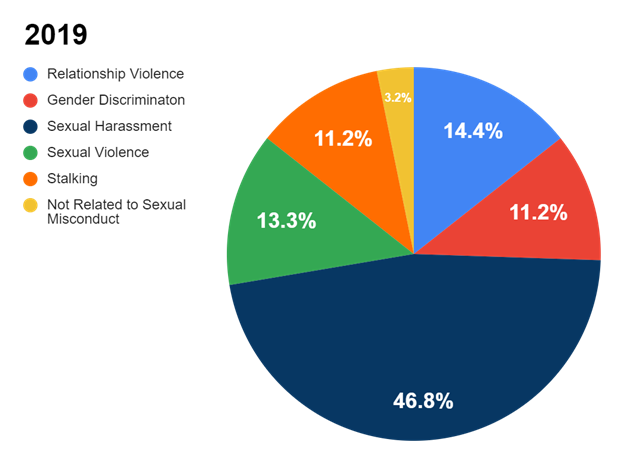 |
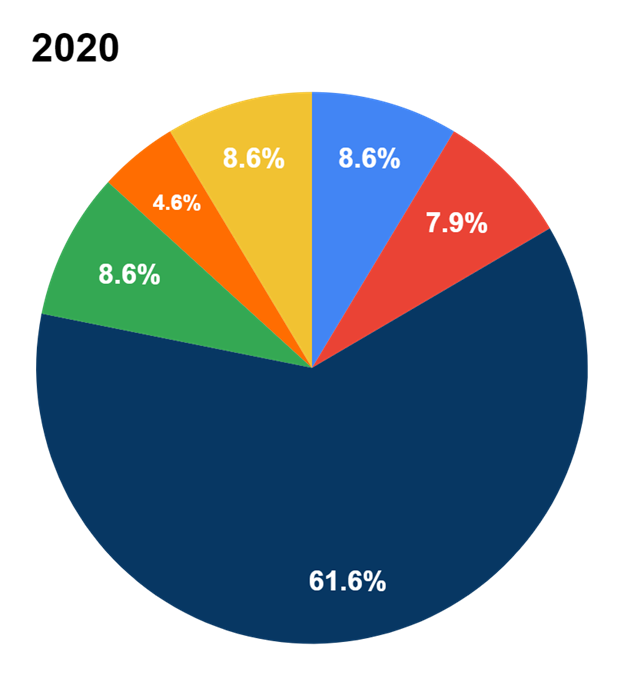 |
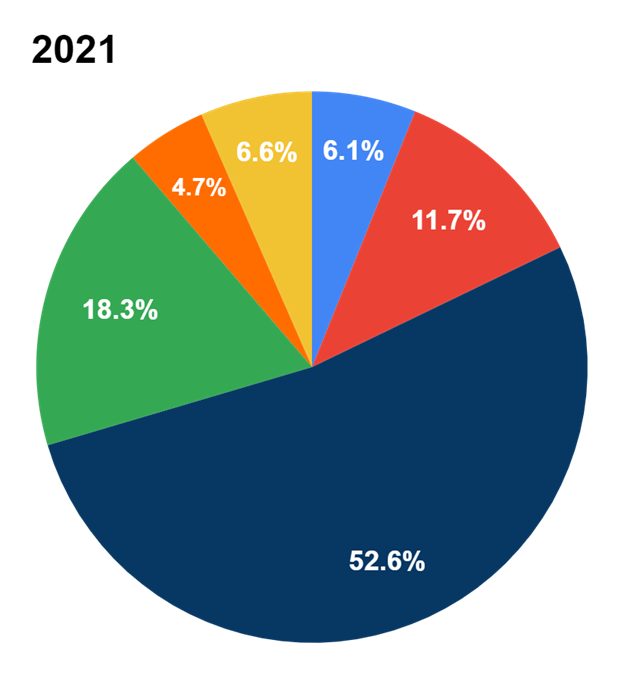 |
Table 2 - Allegations*
| Allegation | 2019 | 2020 | 2021 |
|---|---|---|---|
| AllegationRelationship Violence | 201927 | 202013 | 202113 |
| AllegationGender Discrimination | 201921 | 202012 | 202125 |
| AllegationSexual Harassment | 201988 | 202093 | 2021112 |
| AllegationSexual Violence | 201925 | 202013 | 202139 |
| AllegationStalking | 201921 | 20207 | 202110 |
| AllegationNot Related to Sexual Misconduct** | 20198 | 202013 | 202114 |
Anyone can report allegations related to University Policy P105, P106, and P208. OEA has jurisdiction over discrimination, sexual harassment, and sexual misconduct.
* Allegations have been combined to align with commonly recognized categories. For common categories and their respective definitions please see the University Policy Manual, P105 and P106.
**Some reports to OEA or Title IX do not involve sexual misconduct. The numbers in this table include all reports regardless of whether a subsequent review determined there was no sexual misconduct as outlined by university policies.
Section 5: Education and Outreach - How We Raise Awareness
Jump to: Section 1 | Section 2 | Section 3 | Section 4
A key part of Stony Brook’s efforts to prevent sexual misconduct is education and outreach. OEA and Title IX staff actively work to provide timely, relevant information to the community to raise awareness. Stony Brook University conducts a wide range of sexual harassment and sexual misconduct prevention training programs. These include information presented at orientations for all new employees and for all new students when they arrive on campus. While Stony Brook had utilized online Title IX training starting in 2014, in 2019 OEA wrote and designed our own online program that was customized to provide information related to Stony Brook policies, processes, and resources.
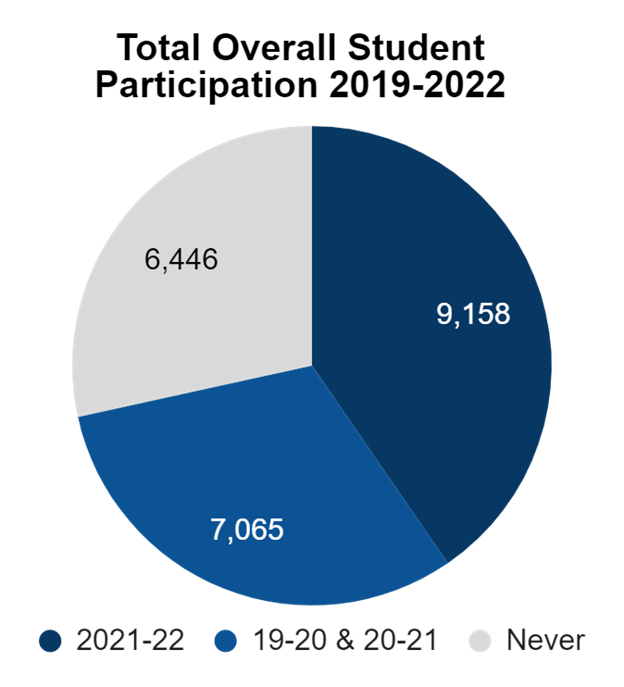 |
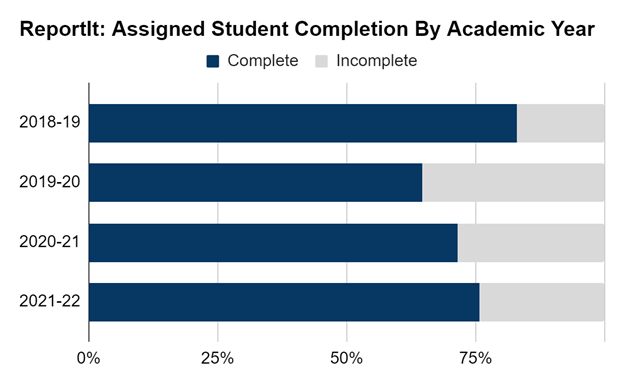 |
Information on OEA, our services and sexual misconduct policies and reporting procedures are still presented in various in-person New Employee Orientation programs and at New Student Orientation. In addition, on-boarding students participate in ReportIt: Ending Sexual Misconduct, the online program providing them with a comprehensive understanding of Stony Brook’s commitment to non-discrimination, including sexual misconduct, and violence, and the importance of affirmative consent. The training also explains how incidents can be reported, provides an overview of the process for investigating and resolving complaints, and discusses bystander awareness and the role that alcohol and drugs often play in incidents of sexual violence.
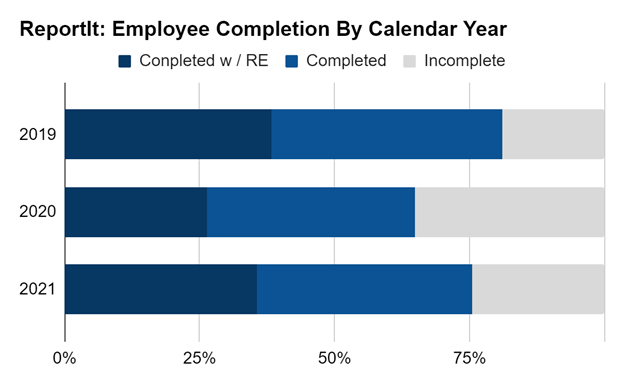 |
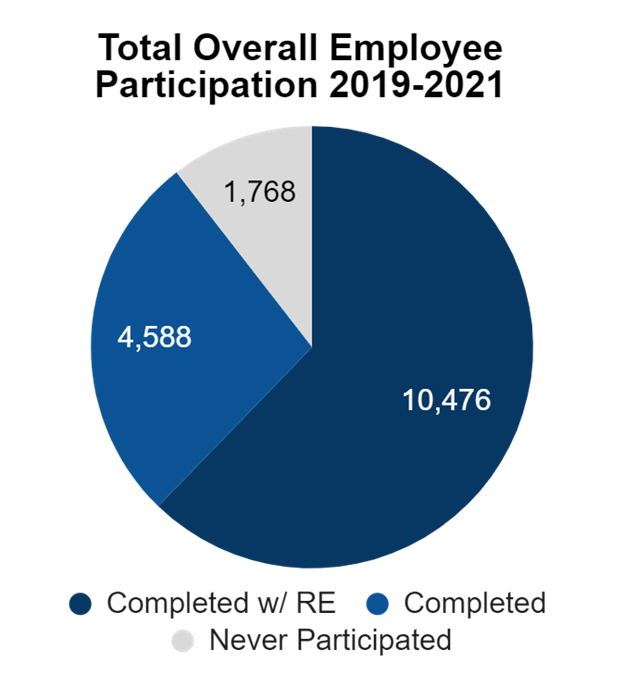 |
New employees take a similar on-boarding program addresses the same themes but focuses on employee concerns. In addition to the on-boarding program, all employees are required to participate in annual review programming designed to ensure that our employees are aware of current policies and reporting options and any changes in their rights and responsibilities. Annual review programs are also required for certain cohorts of students such as athletes, exectuive board members, and resident assistants. Employee versions of the ReportIt program include an additional program for responsible employees – those employees required to report incidents of sexual misconduct - to ensure they understand their responsibility to report. Student and Staff Participation 2019-Present
| Completed | Number |
|---|---|
| CompletedTotal Individuals Completed | Number45,586 |
| CompletedTotal Individuals Completed Two or More Times | Number18,426 |
| CompletedTotal Individuals Completed Responsible Employee Program | Number13,860 |
We are working to raise awareness of the ReportIt training program. Over the past three years, nearly 80% of our current students and staff have participated at least one time. That means that more people in our university community know where to go for help resolving an issue, exercising their rights, and fulfilling their responsibilities under Stony Brook policy and state and federal law. In total, as shown above, more than 45,000 current and former employees and students have participated in the program, with over one-third of them more than once. We hope the broad reach of the ReportIt Program will continue to have a positive impact at Stony Brook and beyond.
